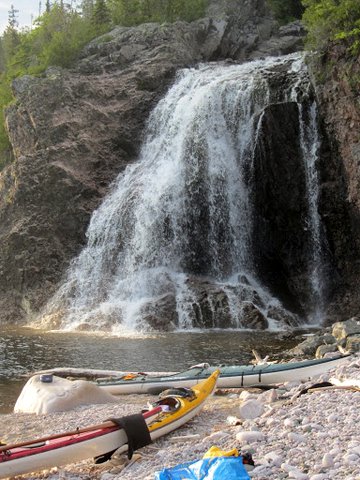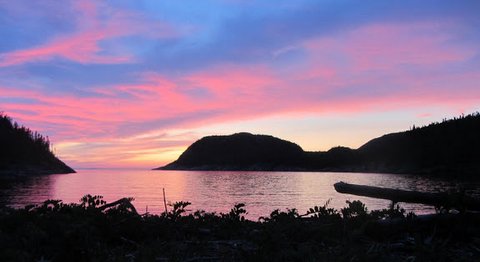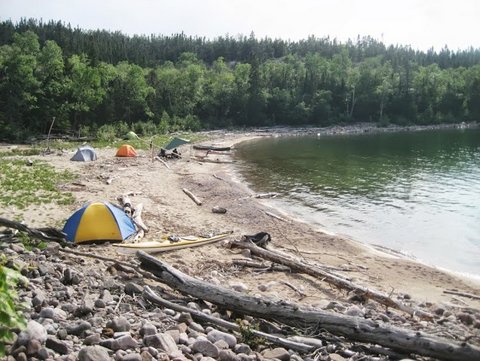
by John Fitzsimons
Although starting off cooler than normal in 2013, the weather in southern Ontario had fallen into that all too familiar pattern of high heat and humidity, made all the worse by a persistent Bermuda high. With climate change, paddling in southern Ontario during the peak season has at times meant enduring high heat and humidity, a situation that is rarely encountered on Lake Superior. Against this backdrop, Sarka Lhotak, Dave Morningstar and I, along with our trip organizer Sam Wyss, headed off on the 12 hour trip to Pukaskwa National Park south of Marathon, for a week of paddling July 13-20. We paddled from the north end of the park at Hattie Cove to the south end at Pukaskwa River, and back again. Paying camp fees which are not trivial but allow gems like Pukaskwa to function and survive in the face of government austerity, allowed us to park our cars in a secure setting for the week while we were on the water, eliminating the need for an outfitter.
I had heard all of the horror stories of paddling on Superior, with some experiencing several days of being wind bound due to high waves and confused seas. An earlier trip on Superior from Silver Islet to Rossport had not had one wind day but that part of the shoreline is somewhat protected. The same could not be said for the Pukaskwa shoreline. Other than for the odd and mostly small island, the Pukaskwa shoreline is very exposed, at times all the way to Duluth!
We threw out the idea of needing helmets for surf landings early in the planning stage, but bearing in mind the relative exposure of the Pukaskwa shoreline and Superiors cold water, were less certain as to other parts of our paddling attire. Both hypothermia and hyperthermia can kill during the summer, and while you can be faced with hypothermia due to excessive exposure to what lies below the water’s surface, hyperthermia can result from conditions above the surface where you are hopefully spending most of your time. So to paddle on Superior in the summer one is faced with a compromise of sorts. Our compromise was to wear wet suits when conditions might lead to upset but otherwise to wear what we might paddle in on Georgian Bay. Although in-water survival time would be much greater in the 20°C temperatures of Georgian Bay compared to the 6°C temperature of Lake Superior during our trip, I rationalized that with the light chop we experienced during most of the trip and our many years of experience, in the unlikely event that there was an upset, one could readily re-enter their boat with the help of their paddling companions before hypothermia set in. Still one only had to take a short dip in the lake to be reminded of the consequences of a lack of protective clothing in Superior. Yes swimming on a Superior trip at temperatures that are humane, is restricted to the rivers en route even for Sarka!
As well as some disadvantages, the cold water on Superior presented several advantages especially this summer. Do you realize that for Superior the average temperature of 6°C is just 2°C off the 4°C recommended for your fridge? This means that things like vegetables that might readily spoil on Georgian Bay can be held for an entire trip on Superior. And your beer is ever so cold and so good with that fresh guacamole. While the refrigerated seat seems to keep any butt issues at bay, I am less sure of the advantages of having refrigerated clothes. For the entire trip air temperatures for the most part remained in the low 20s, so were quite pleasant for paddling while the rest of northeastern North America seemed stuck in a heat wave of epic proportions.
The Pukaskwa shoreline which is one of the most remote on the Great Lakes is relatively small for a large lake like Superior but still quite large. As the crow flies, the Pukaskwa shoreline is 78 kilometres in length, but if you closely follow the shoreline the distance jumps to well over 200 kilometres and you are rewarded by many back bays, nooks, and crannies and the rich history of the place. Pukaskwa Pits, depressions that were dug long ago out of ancient cobble beaches that are at times several metres above the water, are scattered along the shoreline, but remain an enigma. Campsites which are quite varied occur along the length of the Pukaskwa shoreline and are sometimes shared with hikers who travel on footpaths through part of the park. Campsites tend to have thunderboxes with steel bear boxes at some, although we saw no signs of bears. On this trip we camped at White River, Fisherman’s Cove, Cascade Falls, Pukaskwa River, and North Swallow Harbour. Campsites included both cobble and sand beaches; with sand beaches at times looking like they could have been in the Caribbean they were so white. Firewood is usually never a problem on Superior owing to its remote nature, large size, and abundance of trees. On some beaches driftwood was so plentiful it was hard to find a place to pitch a tent.
As remote as Pukaskwa is, it was by no means deserted. We ran into many kayakers and surprisingly enough, canoeists, along the way. As you can imagine canoeing on Superior is no easy task but has its enthusiasts with a wide range of motivations some of which seemed a little idealistic for the place. One young couple we met were headed for the North Channel with the intention of picking up any garbage along the way. An ex-US-Army type all the way from Ohio looked like he would have been at home with the Group of Seven. He had a small dog in tow for company, while keeping in contact on a nightly basis with his invalid wife on a sat phone.


Superior trips don’t come along very often. Club members willing to lead Superior trips are for obvious reasons a rare breed. Not everyone has the paddling and navigation skills or the sense of adventure and physical endurance to take on such a lake. I am really glad that Sam was up for another Superior trip.
[show_metadata]
